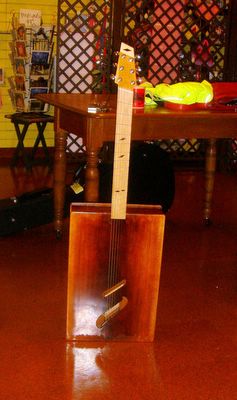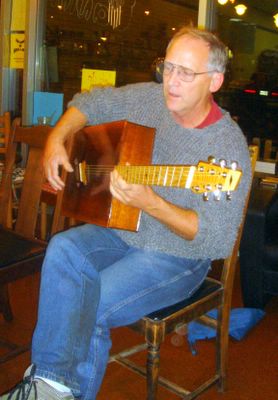Thursday, October 13, 2005

Physics of guitar design
Fascinating article for us strummers and even more so for local luthiers ...
"A guitar is like a woman ... but it is also, to a physicist, like a bunch of pendulums connected by springs: It is a system of coupled oscillators. The first oscillator is the string, but a plucked string doesn't move enough air to emit much of a sound. So the bottom end of a guitar string is attached to a hardwood bridge, which transmits the vibration to the top plate, which transmits it to the rest of the guitar, which transmits it to the air in and around the instrument. Together these oscillators augment the string's feeble output and make it audible."
 No sooner do I find this article than into the Friday Bageleria lopes guitar craftsman Mike Gaffney with his bizarre rectangular 'Bo Diddley' création.
No sooner do I find this article than into the Friday Bageleria lopes guitar craftsman Mike Gaffney with his bizarre rectangular 'Bo Diddley' création.
I find the frets oddly spaced and cannot play anything on it, although it has a nice action and the square body sits well on the lap.
 Then island newcomer Jim G takes it up and ripples effortlessly through a sprightly rag, no prob with the frets whatsoever, damn the fellow.
Then island newcomer Jim G takes it up and ripples effortlessly through a sprightly rag, no prob with the frets whatsoever, damn the fellow.
But I digress from the article's chat about oscillators and feeble output. It appears that,
"Their coupled motion patterns are very complex, and each note on the guitar corresponds to a particular pattern. But each vibration pattern is made up of a sum of simpler vibrations, called modes.
Play an F sharp on the bass E string, for instance (or a G, or G sharp; it depends on the guitar), and the whole instrument will swell and contract like a balloon, albeit indiscernibly, with the top and back plates moving a few microns closer and then apart, roughly a hundred times a second. About an octave higher--at the fourth, fifth, or sixth fret of the D string--the top and back plates move roughly twice as fast, at 215 hertz or so, but now they move in parallel, forward and back at the same time. Another octave or so higher and the bottom end of the soundboard inflates, while the neighboring area next to the sound hole deflates, and vice versa."
Now you know ... and there's more like that.
Roll over Segovia, indeed ...